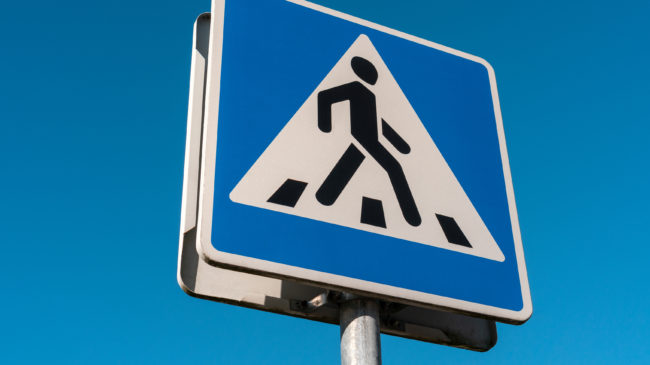October has been declared National Pedestrian Safety Month by the National Highway Traffic Safety Administration (NHTSA). With pedestrian fatalities a rising fraction of total highway deaths, this seems like a worthwhile effort to offer potentially life-saving tips to people who walk or bike. But this well-meaning effort has aroused the ire of some anti-car organizations, which have attacked NHTSA’s efforts using loaded words and questionable premises.
Some of these groups have been trying to get transportation agencies to refer to all traffic accidents as “crashes,” although the standard terminology includes minor fender-benders and things like bumping into lamp-posts. In recent attacks on National Pedestrian Safety Month, some have escalated their rhetoric.
A recent Streetsblog post about NHTSA’s effort by Kea Wilson, for example, refers to accidents as “traffic violence.” The piece reproduces five NHTSA Instagram graphics encouraging pedestrians to be more careful when walking on roadways.
The first suggests that pedestrians carry a flashlight and wear reflective gear when walking at night, which Wilson attacks because NHTSA should instead be advocating federal spending on more local streetlights. NHTSA is accused of falling for the “myth” that “walkers can save their own lives if they just turn themselves into human disco balls after dark.” This is silly, given that many jurisdictions, including Washington, DC, require bicycles to have reflectors and lights so they are more visible at night.
Next is a warning to pedestrians about the dangers of walking while focused on a smartphone rather than watching where they’re going. We all know that both distracted driving and distracted walking can lead to accidents that are sometimes fatal, but the piece says, “There is no graphic about distracted driving” in this set—well no, this campaign, National Pedestrian Safety Month, is aimed at what pedestrians can do.
Third, there’s an image warning that alcohol is a factor in almost half of all fatal pedestrian “traffic crashes” (you can see that NHTSA has already internalized that new term). Wilson admits that roughly one-third of pedestrians hit by cars are drunk, but protests that “walking while drunk, in and of itself, is not a crime, nor is it inherently dangerous to other road users.” Most road users are people driving cars, and the last thing they want to do is run into a drunk pedestrian who has blundered into traffic. But Wilson argues that holding drunk pedestrians to account for their irresponsibility is blaming the victim.
NHTSA’s fourth graphic points out that pedestrian fatalities are greatest for people between the ages of 50 and 64. Wilson chooses to note, “Yes, friends, it’s true: older people are more likely to be killed by cars!” before shifting to berating NHTSA for not advocating better transit options for senior citizens.
Finally, there was a graphic noting that October 7 was “Walk to School Day,” which reminded kids to cross at crosswalks and obey school crossing guards. What’s wrong with that? Wilson scolds that traffic engineers should design roads “that compel drivers to slow down and resist their chances of committing vehicle manslaughter.” Again, asking school kids to be careful when walking to school is apparently another case of blaming the victims.
I’m not a big fan of NHTSA, but Pedestrian Safety Month seems like a worthwhile effort and the kind of things newspapers and TV stations like to promote. In contrast, demonizing drivers while attacking efforts to get pedestrians to be more careful strikes me as uncalled for. It is yet another example of what the late political scientist James Q. Wilson identified as the “war against the auto.”
For many years, some anti-auto people have been trying to change how people think about cars and driving by changing the language. They refer to suburbia (where many of us choose to live) as “suburban sprawl” and call high-density apartments “smart growth.” They argue that only streets with sidewalks and bike lanes are considered “complete” and multi-lane arterials need to have a “road diet” imposed on them. Propagandists know that words can be used as weapons. Defenders of auto-mobility should resist these anti-auto and anti-highway terms and object when transportation agencies adopt them without realizing the agenda behind them.

